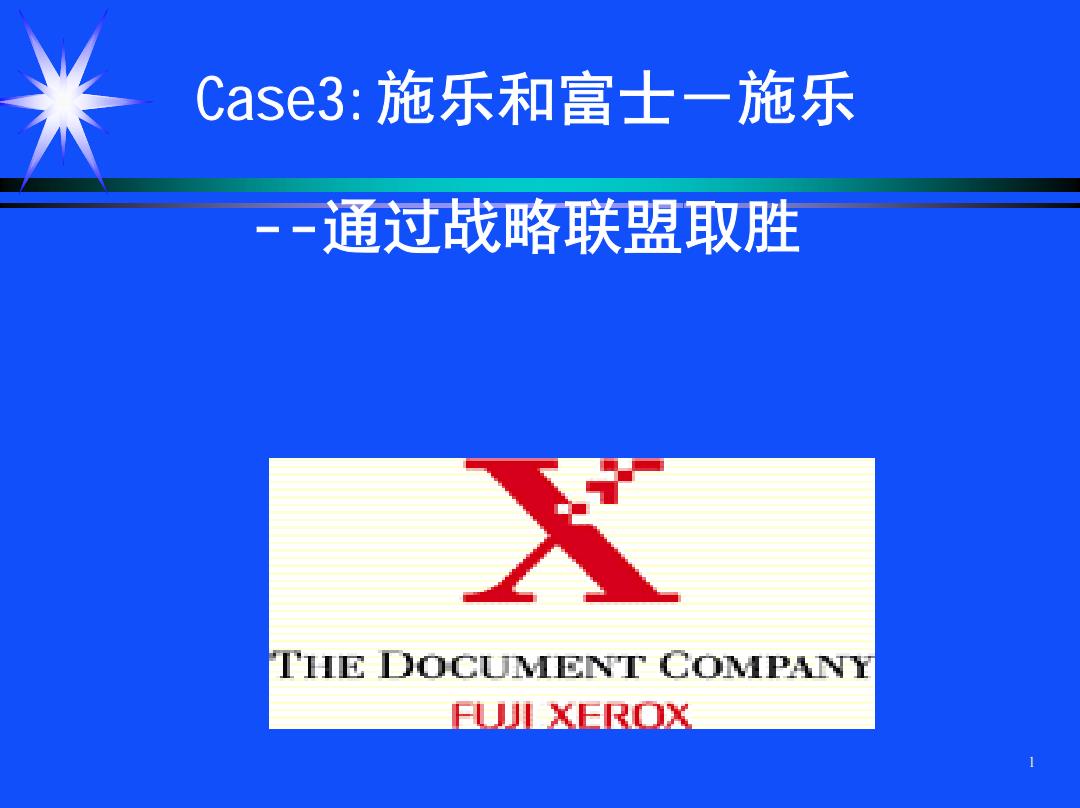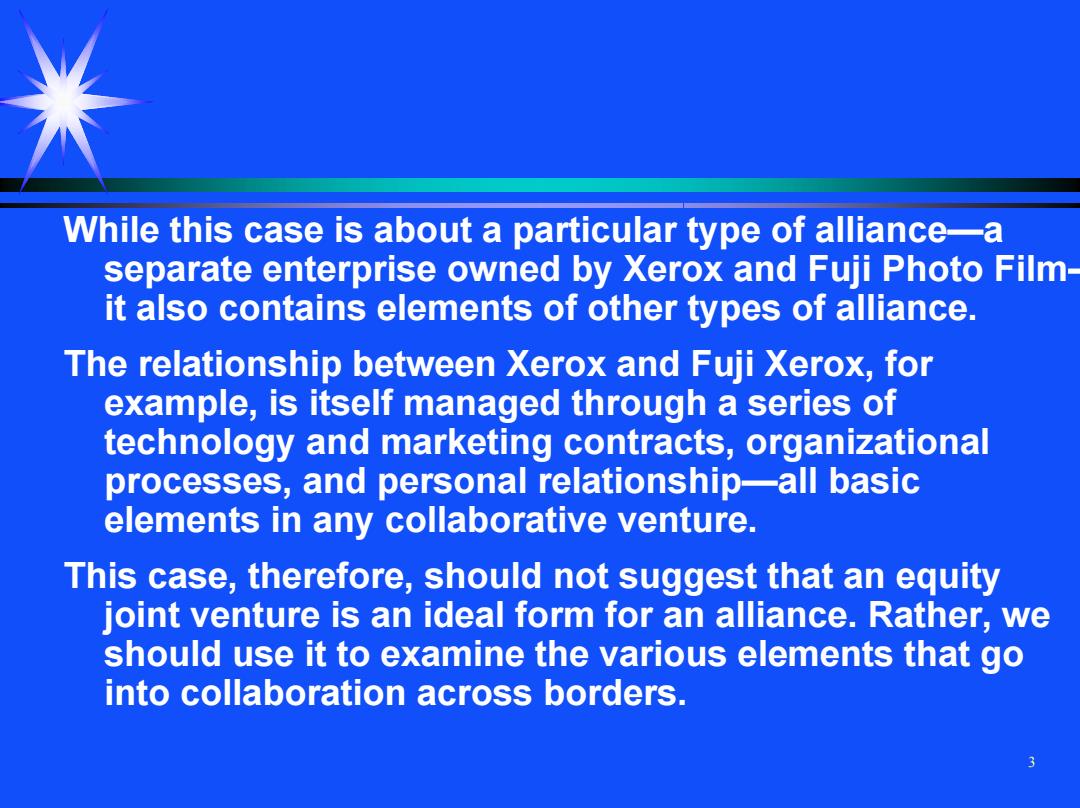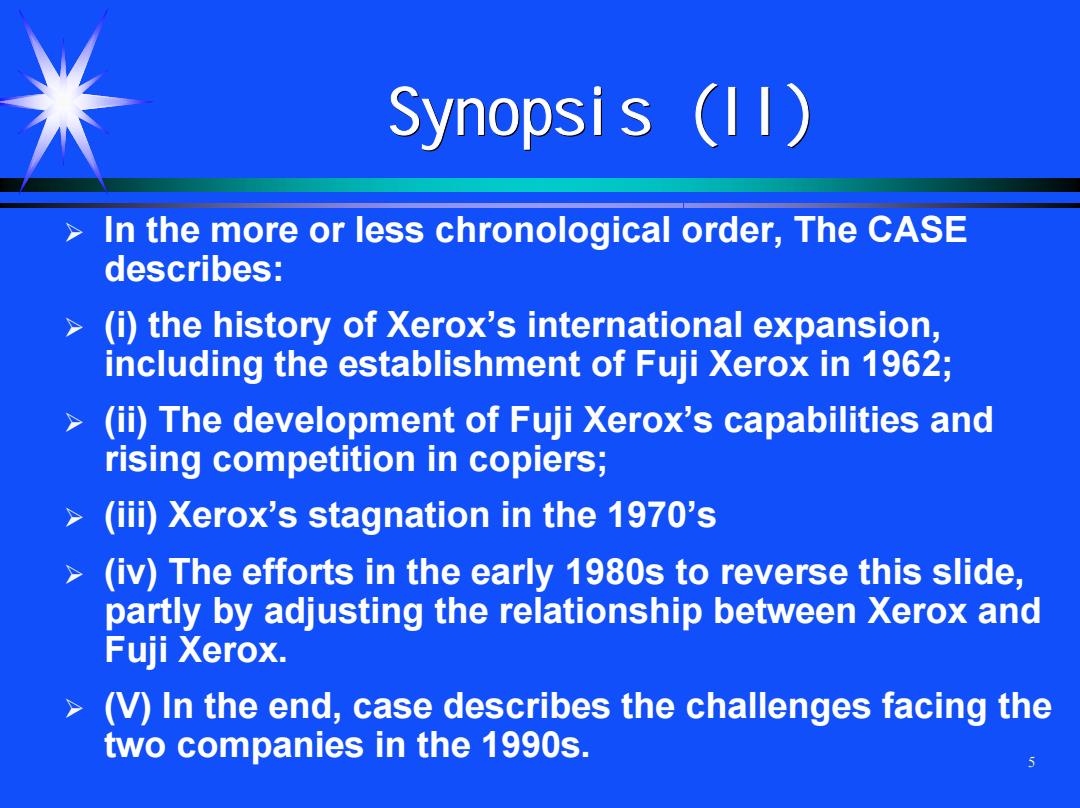
CaSe3:施乐和富士一施乐 --通过战略联盟取胜 THE DOCUMENT COMPANY 且川XEROX 1
1 Case3:施乐和富士-施乐 --通过战略联盟取胜

Synopsis (I) Many of the international alliances being formed today are still too young for us to evaluate their full impact. The case of Xerox and Fuji Xerox gives us a unique opportunity to trace the evolution of such an alliance over a long period of time.We can learn a lot from this experience,and try both to avoid Xerox's mistakes and copy Xerox's success. 2
2 Synopsis (I) Synopsis (I) Many of the international alliances being formed today are still too young for us to evaluate their full impact. The case of Xerox and Fuji Xerox gives us a unique opportunity to trace the evolution of such an alliance over a long period of time. We can learn a lot from this experience, and try both to avoid Xerox’s mistakes and copy Xerox’s success

While this case is about a particular type of alliance-a separate enterprise owned by Xerox and Fuji Photo Film- it also contains elements of other types of alliance. The relationship between Xerox and Fuji Xerox,for example,is itself managed through a series of technology and marketing contracts,organizational processes,and personal relationship-all basic elements in any collaborative venture. This case,therefore,should not suggest that an equity joint venture is an ideal form for an alliance.Rather,we should use it to examine the various elements that go into collaboration across borders. 3
3 While this case is about a particular ty p e of alliance—a separate enterprise owned b y Xerox and Fuji Photo Film — it also contains elements of other t ypes of alliance. The relatio nship bet ween Xerox and Fuji Xerox, for example, is itself managed through a series of technology and marketing contracts, organizational processes, and personal relationship—all basic elements in an y collaborative venture. This case, therefore, should not suggest that an equity joint venture is an ideal form for an alliance. Rather, w e should use it to examine the various ele ments that go into collaboration across borders

What strikes us is the drive of Fuji Xerox's management constantly to expand the scope of the joint ventures capabilities and operations.This contrasts sharply with th gradual decline of Xerox's own competitive position over these years. Xerox's early monopoly with the business was replaced by intense rivalry,mostly with Japanese firms;initially, only Fuji Xerox seemed to have recognized this threat. Xerox woke up to the trend just in the nick of time,it seems,and then relied on Fuji Xerox to begin addressing the competitive challenges. > Whether this strategy succeed,the case suggests, depends on how effectively collaboration between the. companies is managed in the 1990s
4 ¾ What strikes us is the drive of Fuji Xerox’s management constantly to expand the scope of the joint ventures capabilities and operations. This contrasts sharply with th gradual decline of Xerox’s own competitive position over these years. ¾ Xerox’s early monopoly with the business was replaced by intense rivalry, mostly with Japanese firms; initially, only Fuji Xerox seemed to have recognized this threat. ¾ Xerox woke up to the trend just in the nick of time, it seems, and then relied on Fuji Xerox to begin addressing the competitive challenges. ¾ Whether this strategy succeed, the case suggests, depends on how effectively collaboration between the companies is managed in the 1990s

Synopsis (I1) In the more or less chronological order,The CASE describes: > (i)the history of Xerox's international expansion, including the establishment of Fuji Xerox in 1962; (ii)The development of Fuji Xerox's capabilities and rising competition in copiers; (iii)Xerox's stagnation in the 1970's (iv)The efforts in the early 1980s to reverse this slide, partly by adjusting the relationship between Xerox and Fuji Xerox. (V)In the end,case describes the challenges facing the two companies in the 1990s. 5
5 Synopsis (II) Synopsis (II) ¾ In the more or less chronological order, The CASE describes: ¾ (i) the history of Xerox’s international expansion, including the establishment of Fuji Xerox in 1962; ¾ (ii) The development of Fuji Xerox’s capabilities and rising competition in copiers; ¾ (iii) Xerox’s stagnation in the 1970’s ¾ (iv) The efforts in the earl y 1980s to reverse this slide, partl y by adjusting the relationship bet w e en Xerox and Fuji Xerox. ¾ (V) In the end, case describes the challenges facing the two companies in the 1990s